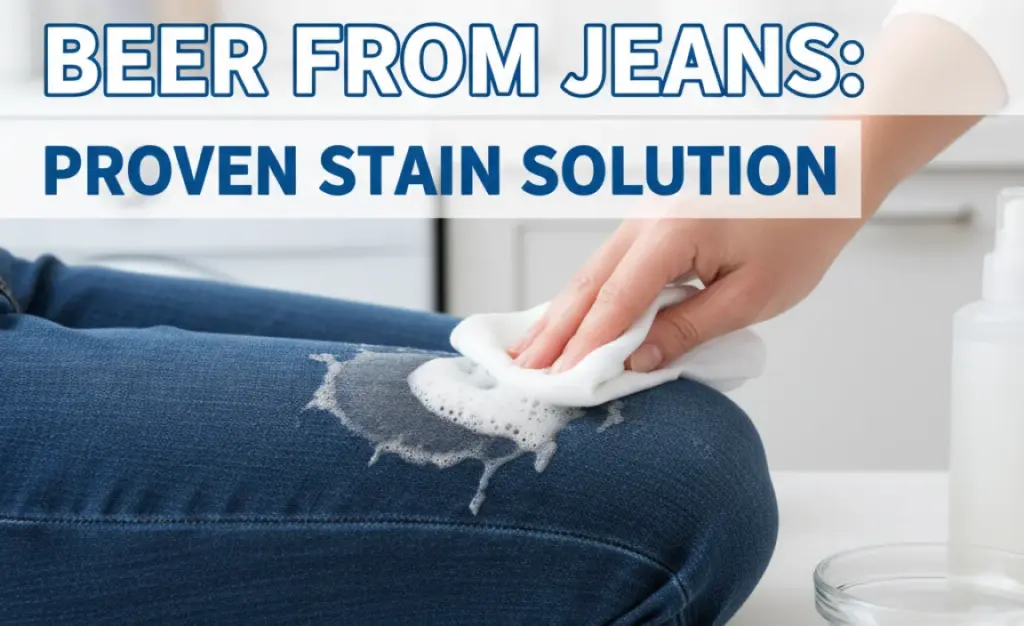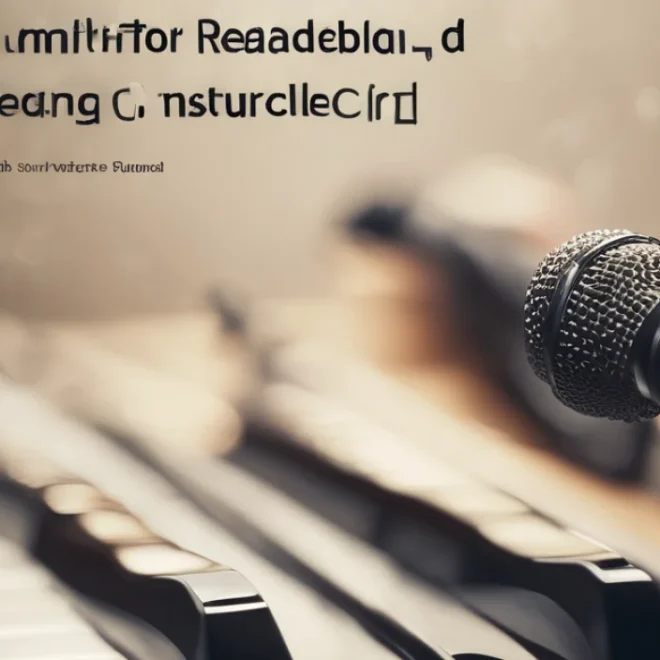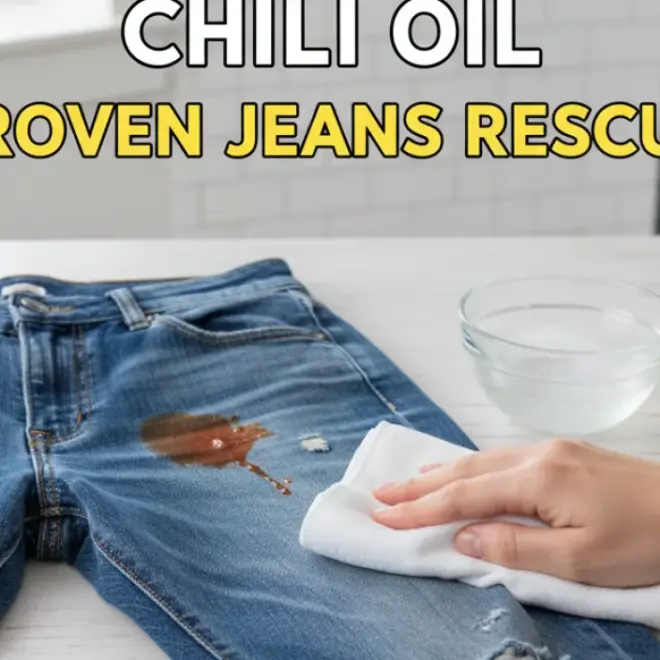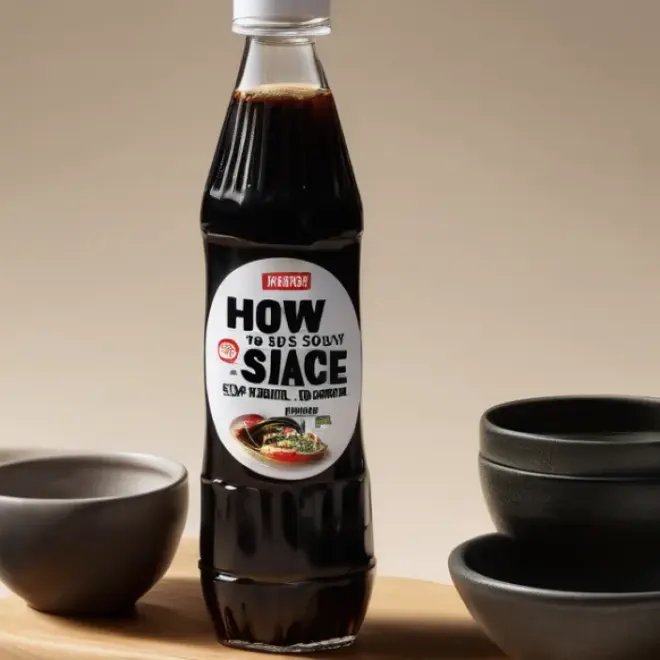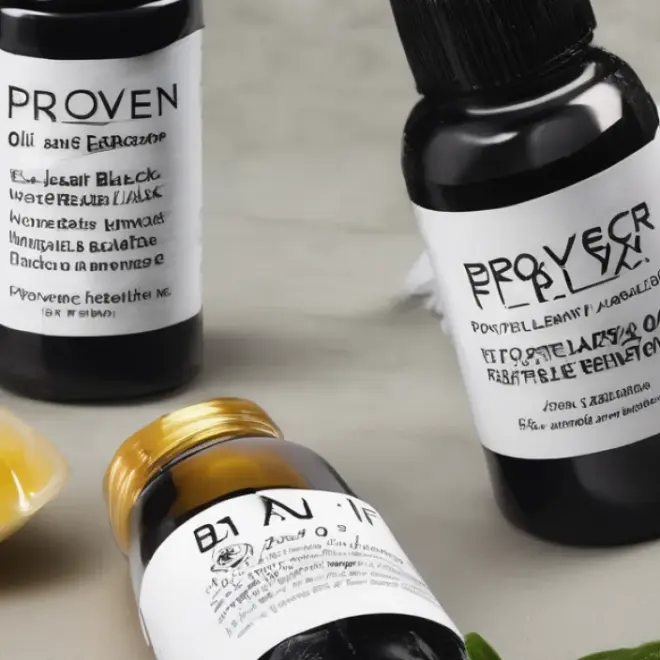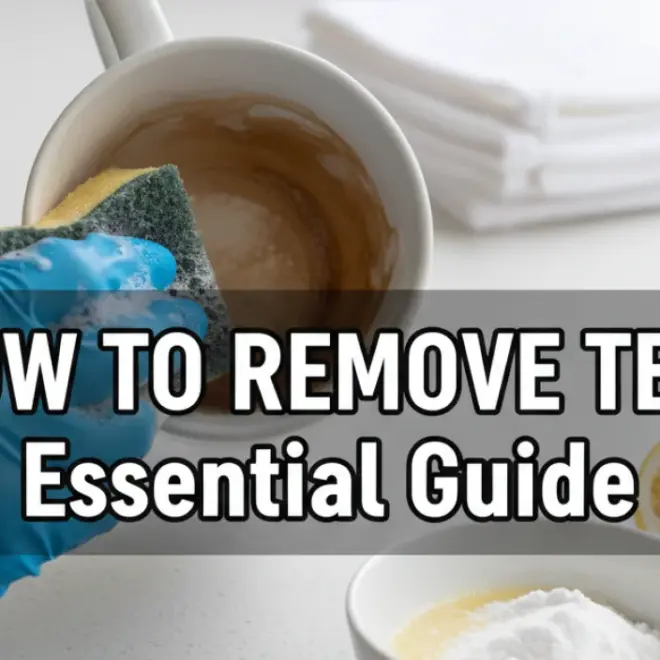Quick Summary: To remove beer from jeans, act fast! Blot the spill, then pre-treat with a laundry detergent or stain remover paste. Wash in cold water. For stubborn stains, a soak with an enzyme cleaner or oxygen bleach can help. Always check for stain removal before drying.
Oh, the dreaded beer spill on your favorite jeans! Whether it happened at a backyard BBQ, a lively concert, or just a relaxed evening at home, a beer stain can feel like a style emergency. Don’t panic! Beer stains are surprisingly common and, with the right approach, entirely manageable. The key is to tackle them quickly and efficiently. This guide will walk you through proven methods to lift that beer stain, restoring your denim to its former glory. Get ready to say goodbye to sticky residue and unpleasant odors, and hello to perfectly clean jeans!
Understanding Beer Stains on Denim
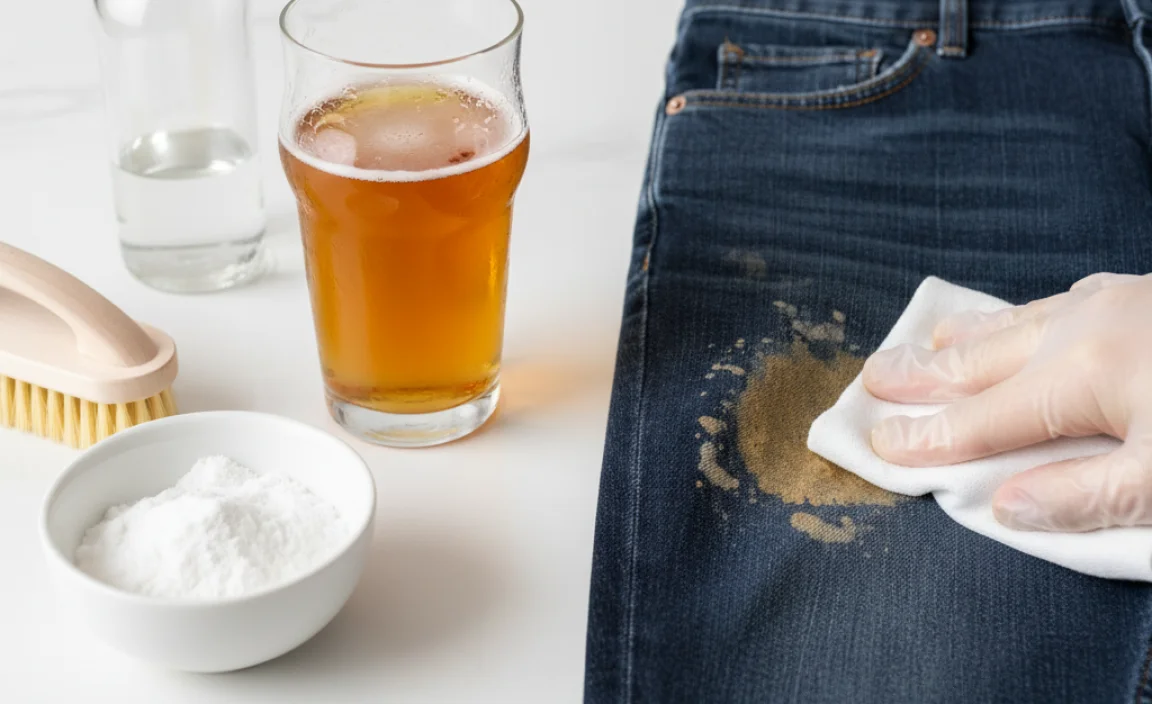
Beer, while delicious, contains sugars, tannins, and proteins that can leave a sticky residue and a noticeable mark on your jeans. If left untreated, these components can set into the fabric, making them harder to remove. The stain might appear as a light brown or yellowish mark, often accompanied by a lingering smell. The risk of the stain setting is higher if the jeans are exposed to heat, especially from a dryer, before the stain is fully gone. Fortunately, denim is a robust fabric, and most beer stains can be removed effectively with simple household items and a little patience.
Essential Supplies You’ll Need
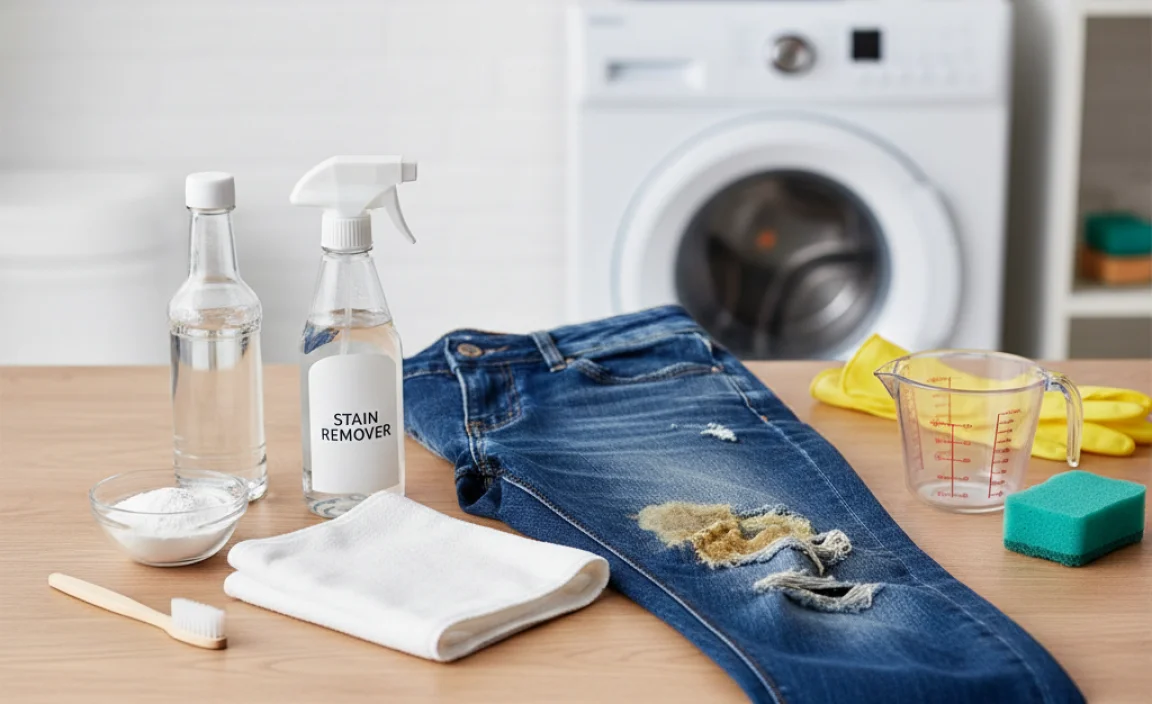
Before you start, gather these common household items to ensure you have everything you need for a successful stain removal mission:
- Clean white cloths or paper towels
- Cold water
- Liquid laundry detergent
- Stain remover (enzyme-based or oxygen bleach are excellent options)
- A soft-bristled brush (like an old toothbrush)
- Optional: White vinegar, baking soda, a spray bottle
Step-by-Step Guide: Removing Fresh Beer Stains
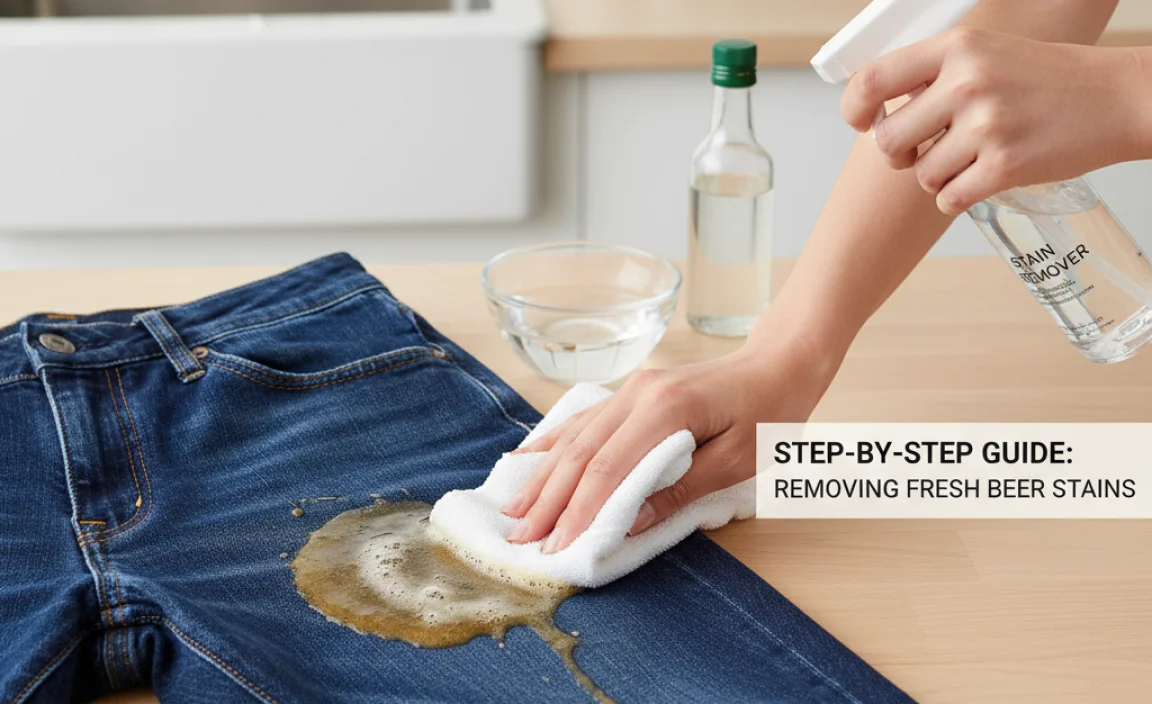
Acting quickly is your best defense against a set-in beer stain. Follow these immediate steps for the highest chance of success:
Step 1: Blot, Don’t Rub
As soon as the spill happens, grab a clean white cloth or paper towel. Gently blot the stained area. The goal here is to absorb as much of the liquid as possible without spreading the stain further into the fabric fibers. Avoid rubbing, as this can push the beer deeper into the denim and make removal more challenging.
Step 2: Rinse with Cold Water
Once you’ve blotted up excess liquid, head to a sink or hose. Turn the jeans inside out and rinse the back of the stained area with cold water. Running cold water through the stain from the back helps to push the beer out of the fibers, rather than further in.
Step 3: Pre-Treat the Stain
Apply a small amount of liquid laundry detergent directly to the stain. You can also create a paste by mixing detergent with a little water. Gently work the detergent into the stain using your fingers or a soft-bristled brush. Let it sit for about 5-10 minutes to begin breaking down the stain components.
Step 4: Wash as Usual (Cold Water!)
After pre-treating, wash the jeans in your washing machine. Crucially, use a cold water setting. Hot water can set protein-based stains, and while beer isn’t purely protein, cold water is always the safest bet for fresh, unknown stains. Use your regular laundry detergent.
Step 5: Inspect Before Drying
This is a critical step! Before you even think about putting your jeans in the dryer, carefully inspect the stained area. If the stain is still visible, do NOT put them in the dryer. The heat from the dryer will likely set the stain permanently. If the stain persists, move on to more intensive treatments.
Advanced Techniques for Stubborn Beer Stains
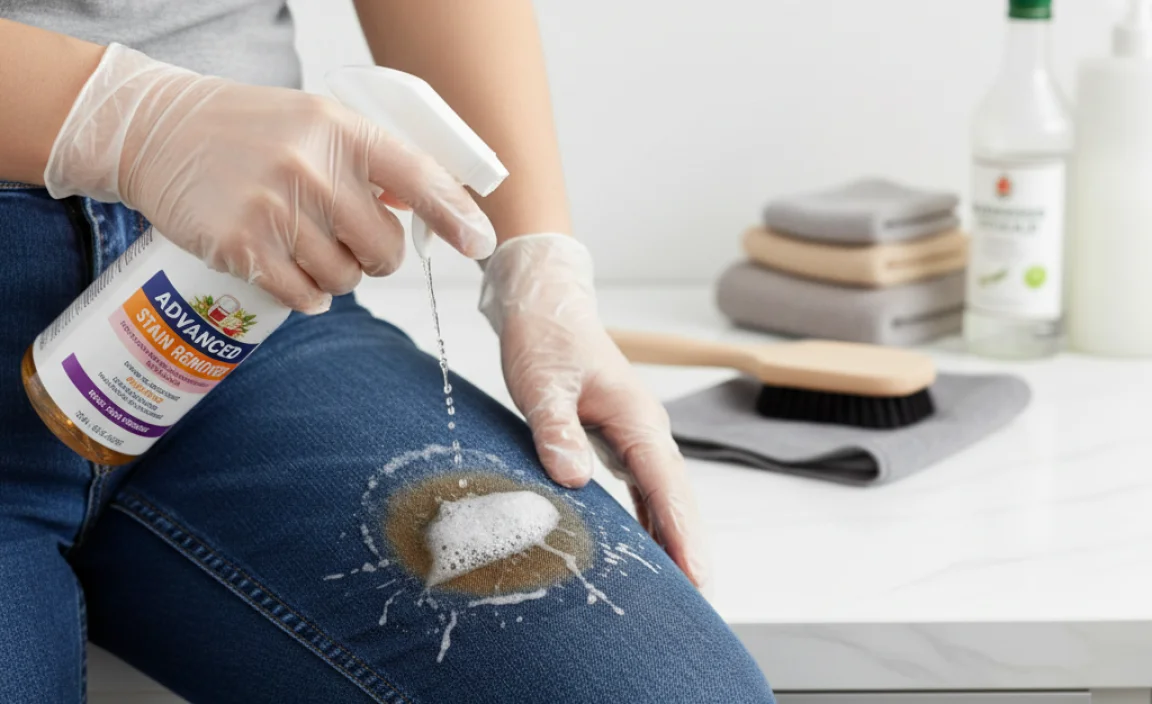
If the initial steps didn’t completely remove the stain, don’t worry. There are a few more powerful methods you can try:
Method 1: Enzyme-Based Stain Remover
Enzyme cleaners are fantastic for breaking down organic stains like those from beer, food, and grass. These cleaners contain enzymes that specifically target and digest the stain molecules. Follow the product instructions, applying the cleaner directly to the stain and letting it work for the recommended time before washing again in cold water. You can find excellent enzyme cleaners at most grocery and department stores. Brands like OxiClean or Shout are widely available and effective.
Method 2: Oxygen Bleach Soak
Oxygen bleach (like OxiClean powder) is a color-safe alternative to chlorine bleach and is very effective for organic stains. It works by releasing oxygen when mixed with water, which helps to lift and break down stains.
How to use an oxygen bleach soak:
- Fill a basin or sink with cool water.
- Add the recommended amount of oxygen bleach powder (check the product packaging for correct ratios).
- Stir to dissolve the powder.
- Submerge the stained jeans fully in the solution.
- Let them soak for at least 1-2 hours, or even overnight for very stubborn stains.
- After soaking, wash the jeans in the washing machine on a cold cycle.
Remember to always test oxygen bleach on an inconspicuous area of the jeans first if you are concerned about color loss. According to the U.S. Environmental Protection Agency (EPA), many “Safer Choice” certified cleaning products, including some oxygen bleaches, are formulated to be effective while minimizing adverse impacts on human health and the environment.
Method 3: The Vinegar and Baking Soda Approach
This natural combination can be surprisingly effective.
Option A: White Vinegar Solution
- Mix one part white vinegar with two parts cold water in a spray bottle.
- Lightly spray the stained area.
- Let it sit for about 10-15 minutes.
- Gently blot, then wash in cold water.
Option B: Baking Soda Paste
- Make a paste of baking soda and water.
- Apply it generously to the stain.
- Let it dry completely.
- Brush off the dried paste, then wash in cold water.
White vinegar acts as a mild acid that can help break down stain components, while baking soda is a natural deodorizer and mild abrasive that can help lift stains.
Special Considerations for Different Types of Beer
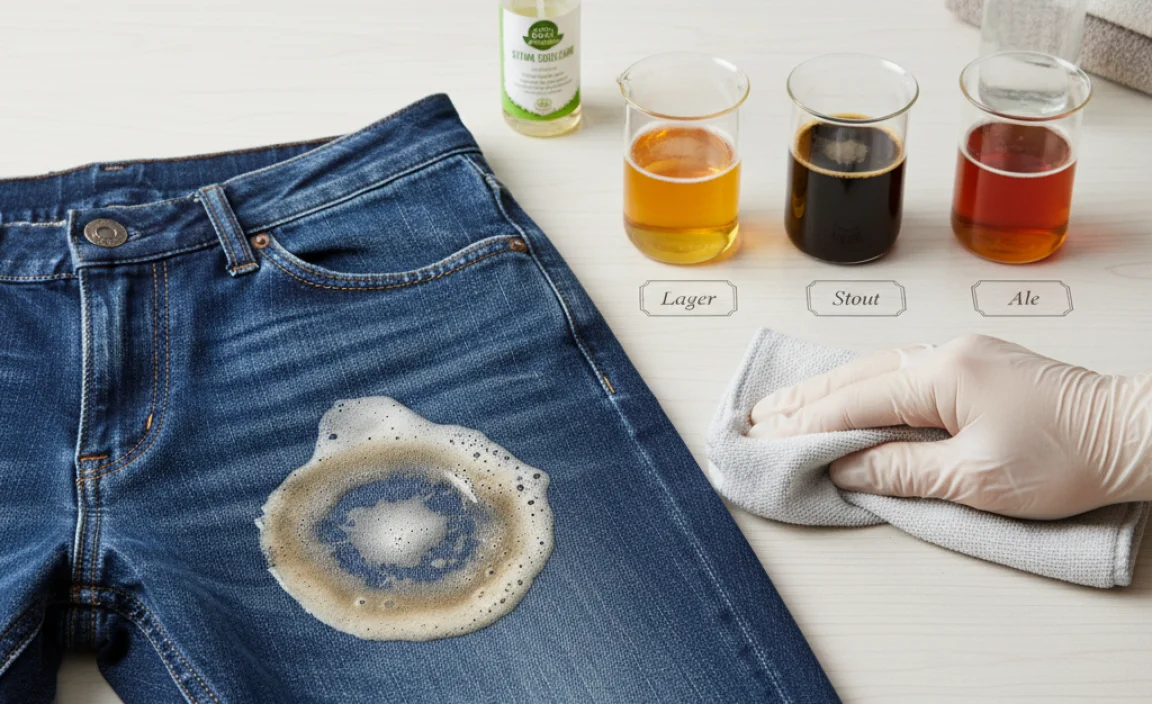
While the general method applies to most beer, certain types might require a slight tweak:
- Dark Beers (Stouts, Porters): These often contain more tannins, which can sometimes lead to a more stubborn stain. Enzyme cleaners or longer soaks with oxygen bleach are particularly useful here.
- Craft Beers with Hops: The bitter compounds in hops can also contribute to staining. The principle remains the same: act fast and use a good-quality stain remover.
- Sweet Beers (e.g., some fruit-infused beers): The added sugars in these beverages can make the stain sticky. Ensure thorough pre-treatment and rinsing to remove all sugary residue.
What NOT to Do
To ensure you don’t make the stain worse, avoid these common mistakes:
- Don’t use hot water initially: As mentioned, heat sets stains.
- Don’t rub aggressively: This can spread the stain and damage fabric fibers.
- Don’t put stained jeans in the dryer: Heat is the enemy of fresh stains. Always air dry until you are certain the stain is gone.
- Don’t use chlorine bleach on colored jeans: Chlorine bleach will remove color and can damage denim fibers. Stick to color-safe options like oxygen bleach.
Table: Stain Removal Timeline and Effectiveness
Here’s a quick look at how different treatments compare:
| Treatment Method | Best For | Pros | Cons | Effectiveness Rating (1-5) |
|---|---|---|---|---|
| Cold Water Rinse & Blot | Immediate Fresh Stains | Quick, easy, readily available. | May not be sufficient on older or large stains. | 3 |
| Liquid Detergent Pre-treat | Fresh to Moderately Fresh Stains | Breaks down initial components, readily available. | Can be less effective on set-in stains. | 4 |
| Enzyme-Based Stain Remover | Organic Stains, Set-in Stains | Highly effective on proteins & sugars. Color-safe. | Requires specific product purchase. May need longer contact time. | 5 |
| Oxygen Bleach Soak | Stubborn Stains, All Colors (safe) | Powerful organic stain fighter. Color-safe alternative to chlorine bleach. | Requires soaking time. Need to check fabric compatibility. | 4.5 |
| Vinegar & Baking Soda | Mild Stains, Odor Removal | Natural, inexpensive. Good for deodorizing. | May be less potent for very tough stains. | 3.5 |
When to Seek Professional Help
For most beer stains on denim, the methods above will be sufficient. However, if your jeans are made of a delicate material, are vintage or particularly expensive, or if the stain has been there for a very long time and resists all home treatments, consider taking them to a professional dry cleaner. They have specialized solvents and techniques that can tackle even the most challenging stains without damaging the fabric.
FAQ: Your Beer Stain Questions Answered
Q1: How quickly should I treat a beer stain on jeans?
A: As quickly as possible! The sooner you treat the stain, the easier it will be to remove. Fresh spills have the best chance of being completely eliminated.
Q2: Can I use regular bleach on my jeans?
A: It’s generally not recommended unless your jeans are white. Chlorine bleach can remove color from dyed fabrics and damage denim fibers. Stick with color-safe alternatives like oxygen bleach.
Q3: Will the beer smell go away?
A: Yes, if treated properly. Washing with detergent, and especially using an enzyme cleaner or a vinegar treatment, will help neutralize and remove any lingering odors.
Q4: What if the stain is old and dried on?
A: Old stains are tougher but not impossible. Try soaking the stained area in an enzyme-based stain remover or an oxygen bleach solution for several hours or overnight before washing. You may need to repeat the process.
Q5: Is it safe to pre-treat my jeans with a commercial stain remover?
A: Yes, most commercial stain removers are safe for denim, especially those labeled for general laundry use. Always follow the product’s instructions and test on an inconspicuous area first if you’re unsure.
Q6: Should I wash my jeans alone after a spill?
A: For the first wash after treating a beer stain, it’s a good idea to wash the jeans alone or with other dark colors, just in case any residual stain or dye is released. This prevents it from transferring to other items.
Q7: Can I use a bar of soap to remove the stain?
A: While a mild bar soap might work on some very light stains, liquid laundry detergent or specialized stain removers are generally more effective as they are formulated to break down the specific components of stains like beer. If using bar soap, ensure it’s a gentle, color-safe variety.
Preventative Measures and Care Tips
While accidents happen, some habits can minimize the risk of stains:
- Be Mindful: When enjoying beverages, especially dark or sweetened ones, be extra careful around your clothing.
- Choose Jeans Wisely: For situations where spills are more likely (e.g., outdoor events), consider wearing darker wash jeans that are more forgiving.
- Protectence Sprays: For premium denim or very light-colored jeans, you could consider fabric protector sprays (like those used for upholstery or shoes), though their effectiveness on clothing can vary. Always test these in an inconspicuous area first.
- Immediate Spotting: Keep a small pack of stain-removing wipes or a travel-sized stain remover handy for on-the-go emergencies.
Proper care extends the life of your jeans. Always check care labels for specific washing instructions. For more detailed information on denim care, resources like Fashionista offer comprehensive guides on maintaining your favorite denim.
Conclusion
Dealing with a beer stain on your jeans doesn’t have to be a disaster. By understanding the nature of the stain and employing a few effective treatments, you can restore your denim and get back to wearing your favorite pair with confidence. The key takeaway is to act swiftly, blot gently, rinse with cold water, pre-treat, and always inspect before drying. Whether you opt for a quick pre-treatment with detergent or a more intensive soak with an enzyme cleaner or oxygen bleach, these methods are reliable solutions. With this knowledge, you’re well-equipped to handle any beer spill that comes your way, ensuring your jeans stay looking as good as new.


